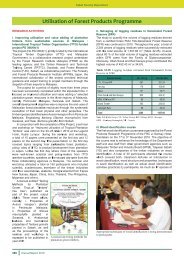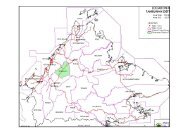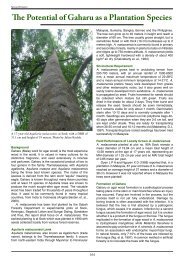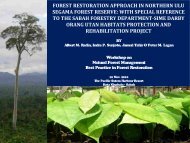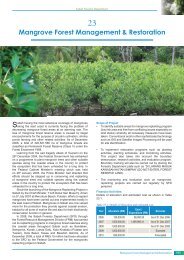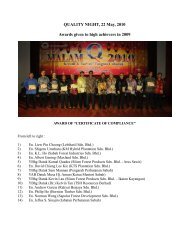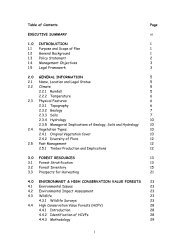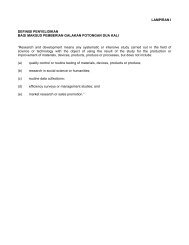Malaysia - Sabah Forestry Department
Malaysia - Sabah Forestry Department
Malaysia - Sabah Forestry Department
You also want an ePaper? Increase the reach of your titles
YUMPU automatically turns print PDFs into web optimized ePapers that Google loves.
1987, Robinson et al. 2001). Interestingly, two specimens were recorded throughoutthe three night sampling at Kawag. Atlas Moths are considered the largest moths inthe world in terms of total wing surface area [upwards of c. 400 cm 2 (62 sq in)]. Theirwing spans are also among the largest, reaching over 25 cm (10 in). Females areappreciably larger and heavier. Atlas Moths are said to be named after either the Titanof Greek mythology, or their map-like wing patterns. In Hong Kong, the Cantonesename translates as "snake's head moth", referring to apical extension of the forewing,which bears a passing resemblance to a snake's head (Wikipedia 2011).Besides the night winged beauties, variousbutterfly species are expected to be found withinthe Kawag Base Camp although no effort wasemployed to sample butterflies in this survey. TheTree Nymph, Idea stolli was sighted more thanfour times at Kawag. It is a large butterfly with awing span of about 15 cm, often seen flyinggracefully in pairs at the fringe of the forest.Figure 9: Idea stolli.Although the Rajah Brooke’s Birdwing (Troides(Trogonoptera) brookiana) and other Birdwings(Troides spp.) were not sighted during the survey, they are expected to be found in thelowland forest of Kawag. Both are protected species under the Wildlife ConservationEnactment 1997.Among the large beetles sampled at Kawagwere the Three-horned Beetle, Chalcosomamoellenkampi and Stag Beetle, Odontolabisdalmani. The Three-horned Beetle is among thelargest beetles in <strong>Malaysia</strong>. Although it isconfined to Borneo, it is a locally commonbeetle. The male Stag Beetle of O. dalmani,measuring about 65 mm has a pair of hardmandibles, about 12 mm in length. BesidesBorneo, it is also found in Peninsular <strong>Malaysia</strong>,Sumatra and Java.It is also noteworthy to mention the presence of‘fire ants’ at Kawag Base Camp. The ants arefrom the subfamily Ponerinae, identified as Figure 10: Odontolabis dalmani.Leptogenys processionalis. They forage incolony of hundreds or thousands, and mostly active at night. It is an irritating speciesbecause they bite and sting any intruders which pass or step on their swarming trails,as we have experienced during light-trapping. The ants swarmed the light-trappingground in search for insects dropped onto the ground.Other butterflies, moths, beetles and insects of other groups recorded during the EIAsurvey at USM FRs are listed in Appendix 1. Some moths and beetles are showcasedin Figures 11 and 12 respectively.11



